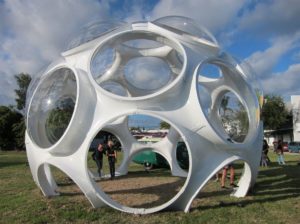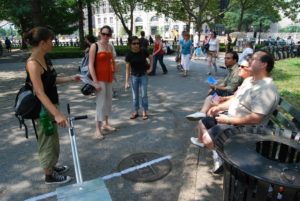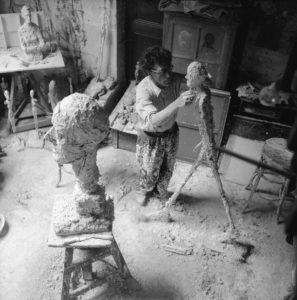Creative Arts and Digital Transformation
Post by Danielle Krcmar, Associate Director of Visual Arts
Did you know that an actress, Hedy Lamar, and a composer, George Antheil, are the inventors responsible for the signal technology which ensures that your cell phone messages can’t be easily intercepted? The encryption technology known as frequency hopping was far ahead of its time, patented in 1942 and initially rejected by the US NAVY, eventually used by the military during the 1962 Cuban Missile Crisis, and now an integral aspect of the wireless technology we depend on daily.i Other artists such as Buckminster Fuller, Kenneth Snelson, Wallace Walker, Jonathan Kingdon, and Abbot Thayer are just a few artists who have made contributions to scientific and technological innovations.

Buckminster Fuller Fly Eye Dome
Innovation is dependent on curiosity, creative thinking, and the ability to shift perspectives, all of which are key components of Artistic and Scientific Processes. A 2008 Michigan State University study by Robert Root Bernstein found that Nobel Prize Winning Scientists were significantly more likely to engage in arts and crafts avocations than other scientists and members of the public. Relative to typical scientists, Nobel prize winners are 22 times more likely to perform as actors, dancers or magicians; 12 times more likely to write poetry, plays or novels; and twice as likely to play an instrument or compose music.ii A previous blog post in the dXi series states that the future of digital success will not be for those who master the technologies but for those who offer the most attractive digital experience. Artists are interested in creating an emotionally resonant experience for their audience as opposed to an attractive one. They make aesthetic objects or performances through processes that have parallels to the Design Thinking steps of Empathy, Problem Definition, Ideation, Prototyping, and Testing to translate ideas, experiences and concerns into works of art that may delight or disgust, surprise or soothe, often connecting seemingly disparate concepts to create something new and beautiful.

Let’s look at the design thinking stages and look at the connections to Artistic Practice.
Artists often create as a means to understand the world around them, and in doing so may create something that helps others to imagine life outside their own lived experience. Reading Other Minds, a study done at the University of Toronto found that frequent fiction readers scored higher on non-self-report measures of empathy. The medical schools UT Austin and Harvard are among many who are visiting galleries as part of the curriculum to enhance deep observation and build empathetic communication.iii

Artist Eve Mosher mapping the 10 foot above sea level line in NYC, NY.
Problem Definition is one of the starting points of the Artistic Process. Artists set up their own problems or areas of limitation so they can truly explore an idea in depth or respond to a concrete problem visible in the world, and look to find ways to communicate the depth of that problem in a different way in order to draw attention to it.
Eve Mosher’s Highwater line project visualizes climate change by drawing chalk-lines on city sidewalks and streets to map the lines of rising sea levels, making the future impact of climate change concretely apparent to residents whose lives will be impacted.
The deceptively humble sketch book is the original ideation space, where page by page, the thought process is articulated and documented chronologically as artists draw, annotate, and alter their observations and ideas.

Leonardo DaVinci’s notebook page, the British Library.
Leonardo DaVinci’s notebooks have now been digitized by the British Library.
For the sculptor, Maquettes or studies, made in a smaller scale or with quickly assembled materials are the prototypes in which to test balance and proportions before beginning the final work in full scale or finish materials.

Alberto Giacometti Holding Three Men Walking

For many, the Test phase cycles into ideation and prototyping, there are often initial materials and process tests as artists try to bring the visions in their heads to life in the studio. For others, the true test of the work occurs as a range of viewers experience and respond to the artwork in the studio and out in the world.
Whether in music, theater or visual art; making art and experiencing the art of others is an essential part of what makes us human. As it turns out; it not only feeds the soul; it’s likely to make you a better innovator, too.
Sources
i Wenner, Melinda (2008) Hedy Lamarr: Not Just a pretty face. How one of the best known actresses of mid- 20th century revolutionized weapons systems and helped create cell phones. Scientific American, June 8, 2008
ii Root-Bernstein, Robert & Allen, Lindsay & Beach, Leighanna & Bhadula, Ragini & Fast, Justin & Hosey, Chelsea & Kremkow, Benjamin & Lapp, Jacqueline & Lonc, Kaitlin Adreessen,(2008) Arts Foster Scientific Success: Avocations Of Nobel, National Academy, Royal Society, And Sigma Xi Members. Journal of Psychology of Science and Technology, Volume 1, Number 2, 2008
iii Hoinski, Michael (2017) Improving Medicine with Art. New York Times, March 11, 2017
